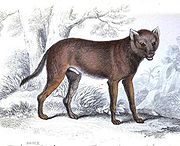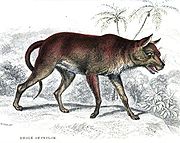|
Tami Nadu - Wildlife of Tamil Nadu - Wildlife of Tamil Nadu
Dhole at Tamil Nadu
The Dhole (Cuon alpinus), also known as the Asiatic Wild Dog, Indian Wild Dog, or Red Dog, is a species of Asian canid, and the only member of the genus Cuon.
The Dhole has many physical similarities to the African Wild Dog and the Bush Dog, most notably in the redundancy of the post-carnassial molars, though whether this is an example of convergence or close relationship is a matter of debate.
The Dhole typically weighs 12–20 kilograms (26–44 lb and measures 90 centimetres (35 in) in body length and 50 centimetres (20 in) shoulder height. The tail measures 40–45 centimetres (16–18 in) in length. There is little sexual dimorphism. The Dhole has a broad, domed skull and a short, broad muzzle. The bones of the forehead and upper jaw are "swollen", producing a dish-faced profile. The hooded eyes have amber or light brown irises, and the ears are large and rounded |
|
Reproduction
Sexual dimorphism is not very distinct with no quantitative anatomical differences known. Both males and females become sexually active at one year old, though females usually breed at 2 years in captivity, and in the wild, for the first time at 3 years, possibly due to physiological and behavioural restraints. Females exhibit seasonal polyoestrus, with a cycle of around 4–6 weeks. Pups are born throughout the end of fall, winter, and the first spring months ( November - March ) - dens are earthen burrows, or are constructed amongst rocks and boulder structures, in rocky caverns, or close to streambeds. In East Java, the Dhole is thought to mate mainly between January and May. Unlike some other canid species, the Dhole does not engage in a copulatory tie when mating. Also, mating is not as restricted to certain individuals as it is in wolf packs, in which usually only the dominant pair can breed.
After a gestation period of around 60–62 days, females usually give birth to about eight pups (though the range is 5-10, the record is 12, and sizes vary drastically within the same pack through different years), which weigh 200-350g. Dhole growth rate is faster than that of wolves, being similar in length to that of the coyote. At 10 days their body weight has doubled, and body length is 340mm. Pups are weaned between 6 and 9 weeks. In captivity, weaning is sometimes recorded later on in the range. By 8 weeks, younglings are less quarrelsome and aggressive, and more vigilant. At three months litters go on hunts, though the pack may not be fully mobile until eight months. Young reach sexual maturity at about a year, and full adult size at 15 months.
After birth, a few other adults will help to feed the young of the dominant pair. The pups, as early as the age of three weeks, and the mother are fed regurgitated meat. When lone females breed, rearing the litters only results in limited success.
Diseases
Dholes are in danger of catching infectious diseases when they come in contact with other animals, especially canines — including feral and domestic dogs. They have been known to suffer from mange, canine distemper, and trypanosomiasis. Canine parvovirus was recorded in Dhole populations in Hodenhagen, Germany and Chennai, India zoos. Sporadically, the Dhole is a health risk for human beings, since their excreta contain transmittable pathogens (e.g. Toxocara canis). Dhole waste has also been found to contain roundworm, cestodes, and other endoparasites. Like other canines, the Dhole can catch rabies; in the 1940s, rabid Dholes bit and infected villagers in the Biligirirangan Hills in India.
Taxonomy

Illustration of a common dhole

Illustration of a Ceylon dhole
Evolution
The Dhole is a glacial period survivor like the Gray Wolf. During the glacial period, the Dhole ranged across Eurasia and North America. A canid called the Sardinian Dhole (Cynotherium sardous) lived on the Mediterranean island of Sardinia during the Pleistocene, but it is not as closely related to the living species as its name would imply A comparative study on dhole and other Canid mtDNA in 1997 showed that dholes diverged from the Lupus lupus lineage before the Black-backed Jackal (Canis mesomelas) and the Golden Jackal (Canis aureus) diverged, a couple of million years before the domestication of the dog.
|
